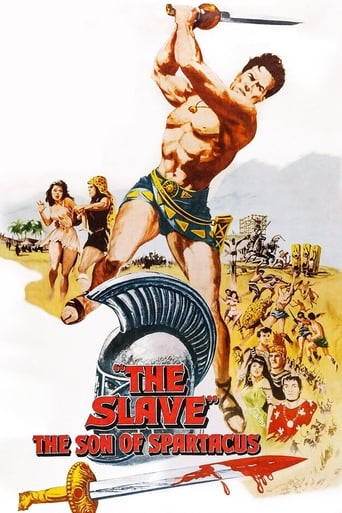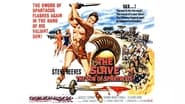Wizard-8
Probably due to the fact that it got backing from a major Hollywood studio, the Italian sword and sandal movie "The Slave" is one of the best looking examples of the genre that reigned in theaters in the 1960s. The shot in Egypt backdrop looks haunting and spectacular, the sets look gigantic and authentic, and the costumes are also first rate. It's a pity then, however, that the feel of the movie is less of a grabber (and much less fun) than many other sword and sandal movies that were churned out on much lower budgets. The story is kind of slow and talky, and the action not only often takes a long time to come, its choreography and direction is strictly routine at best. Another big problem with the movie is the depiction of the main character. There is somewhat less focus on the protagonist than you might think, and as a result he doesn't feel up front and center. It's also hard to figure out what exactly pushes him to embrace his heritage. As the protagonist, Steve Reeves somehow has less charisma and screen presence than he had in other movies of this kind. I wouldn't say this movie is terrible, but it wastes a lot of potential, and I would only recommend it to people who are really into the sword and sandal genre.
jake-179
One of the better Sword and Sandal movies from the golden era of the genre (the 1960's). Awesome to see Steve Reeves in his prime. If this movie had been made in the 1980's, no doubt Schwarzenegger would have been the lead. Beautifully shot on location in Egypt, the setting really does seem to improve the movie. Lot's of action, plenty of sword fights and cool set pieces. I think what stood out to me the most about this movie was the similarities to the "Zorro" story. Reeve's character is a bit like a super hero, darting off out of view to change in to a costume (son of Spartacus) that hides his true identity. Zorro would leave his mark, a "Z" carved with his sword. Son of Spartacus leaves an "S" carved or painted in to shields and walls to terrorize the abusive governor. It really did strike me as "Zorro" set in Roman times and happening in Egypt. Check out the size of the mole on the neck of the guy that played Caesar. Holy crap, he should have had that thing surgically removed. It was like a vestigial twin living on his shoulder/neck. Grotesque! Overall, a good sword and sandal movie that I would have loved when I was 8 - 12 years old. Somehow I only just saw this movie for the first time now that I am 45 years old, but I still enjoyed it.
melvelvit-1
Steve Reeves plays a high-ranking Roman centurion who finds out he's the son of the infamous rebel slave leader and spearheads a revolt, of course, in one of the better "sword & sandal" entries. Mixing the backstory of Moses (instead of a swaddling cloth, an amulet gives him away) with the exploits of a comic book superhero (Reeves sneaks off every now and then to shuck his tunic for dad's face-covering armor), director Corbucci took the tale and ran with it, producing some impressive mise-en-scène amidst his unexpectedly inventive camera-work. Gianna Maria Canale as Crassus' cougar wife does little more than lounge around on divans and ogle our hero but no matter, it's always a pleasure to see her in peplum like this.
frank_olthoff
That "Il figlio di Spartacus" is one of the better sword'n'sandal flicks of the main period (1958-64) is basically due to two aspects: a fluent storyline and original sets in Egypt.Writers Adriano Bolzoni, Bruno Corbucci and Giovanni Grimaldi (plus perhaps director Sergio Corbucci) have scripted a plot that continues the story of Spartacus where Stanley Kubrick left off in 1960 in his Hollywood production with Kirk Douglas. While Kubrick certainly stuck to the historical facts, the follow-up is complete fiction. Tough daredevil Douglas is replaced by smart bodybuilder Steve Reeves as his son, although this was not the worst choice. Reeves, the original Hercules performer of 1958, does quite well in the rôle of Randus, a Roman centurio (this seems to be considered as the highest military rank in "peplums"!), who is confronted with the fact that he seems to be the son of the legendary slave leader, Spartacus, who had once been smashed and crucified by the Roman consul, Crassus. Reeves' good looks distinguish him from Douglas very remarkably, but there's his Germanic combatant Verus (Franco Balducci), who is styled like Douglas two years ealier.They needed to change history to a considerable extent (the story takes place in 48 B.C. when the real Crassus was already dead for five years) so that the fictive Randus could be 23 (Reeves was 36 by then) and Caesar could be involved. Note that the Sphinx has already lost its nose (which it did only 1850 years later) while serving as a likeable background to a talk between Caesar (Ivo Garrani), his adjutant Verulus (Renato Baldini, who has almost nothing to say), and Randus. Choosing the Egyptian landscape, including desert, oases and the pyramids of Gizeh, for the outdoor scenes adds greatly to the picture's atmosphere.Corbucci manages to handle the camera positions and angles very well, almost experimentally for a production like this. Director of photography was Enzo Barboni, the later standard director of the Terence Hill/Bud Spencer movies. There is a foreshadowing of the spaghetti westerns not only in the techniques, but also with a surprisingly high level of brutality as depicted by Corbucci.The story's main idea has Randus in the dilemma of being a Roman officer on the one hand and having the experience of being enslaved on the other. Only in this situation, he feels into the slaves' minds and puts himself at the head of the revolt against Crassus. The rest is a bit stealing from the "Zorro" idea, including the "S" (for Spartacus) mark. As Western European ideology would have it (we're at the climax of American-Russian confrontation) before a revolutionary attitude became fashionable in Italo westerns, Randus fights for freedom (from slavery), not for redistribution of capital.Gianna Maria Canale, leading actress of many a peplum since the earlier days (playing the title rôle in "Teodora", among others), is fine as Crassus' love interest. But Claudio Gora can give all he can as the terrible Crassus, right down to an exaggerated paranoid Nero-like figure.It's worth while, anyway.






